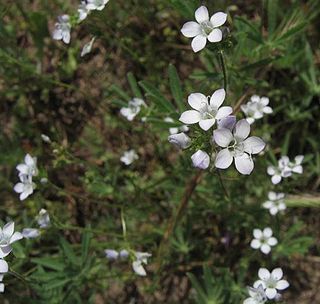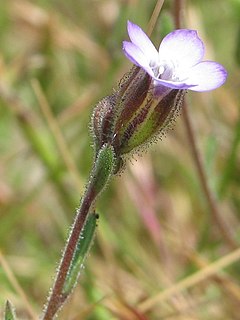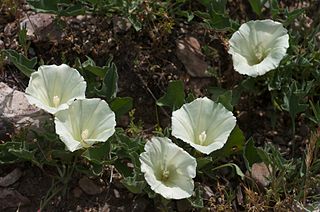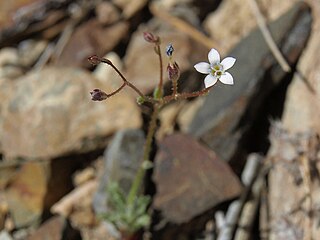
Gilia angelensis is a species of flowering plant in the phlox family known by the common name chaparral gilia. It is native to the coastal hills and mountains of California and Baja California, where it is a member of the chaparral ecosystem., especially in the Transverse Ranges.

Gilia brecciarum is an annual flowering plant in the phlox family (Polemoniaceae), known by the common name Nevada gilia or break gilia.

Gilia millefoliata is a species of flowering plant in the phlox family known by the common name manyleaf gilia. It is native to the coastline of Oregon and northern California, where it grows in sand dune habitat.
Gilia minor is a species of flowering plant in the phlox family known by the common name little gilia. It is native to the Mojave Desert and it is also present in the coastal Santa Lucia Mountains of central-southern coastal California.

Gilia scopulorum is a species of flowering plant in the phlox family known by the common names rock gilia and Rocky Mountain gilia. It is native to the Mojave and Sonoran Deserts.

Ipomopsis congesta is a species of flowering plant in the phlox family, known by the common name ballhead ipomopsis. It is native to much of western North America, where it grows in many habitats from alpine peaks to low-elevation scrub. It is a perennial herb which varies in appearance, especially across subspecies and climates. It may take the form of a squat patch with stems under 10 centimeters in height or a more erect form up to 30 centimeters tall. The stems are often hairy to woolly. The thick leaves are usually fork-shaped with a number of clawlike lobes and 1 to 4 centimeters long. The flowers appear in a rounded, dense cluster atop the stem. Each flower is bell-shaped to funnel-shaped and white with a pale yellow throat and protruding yellow or white stamens. There are several subspecies, many of which were formerly considered species of Gilia.

Saltugilia splendens is a species of flowering plant in the phlox family known by the common names splendid woodland-gilia, Grinnell's gilia and splendid gilia.

Calystegia subacaulis is a species of morning glory known by the common name hillside false bindweed.

Gilia aliquanta is a species of flowering plant in the phlox family known by the common name puffcalyx gilia. It is native to the Sierra Nevada mountains and deserts of southeastern California and southern Nevada.
Saltugilia caruifolia is a species of flowering plant in the phlox family known by the common names carawayleaf gilia and caraway-leaved woodland-gilia. It is native to the Peninsular Ranges of southern California and northern Baja California, where it grows in local habitat types such as chaparral. This herb produces a thin stem 12 centimeters to about a meter long. The leaves are up to 8 centimeters long at the base of the plant and divided into many finely subdivided lobes. The top of the stem branches into an inflorescence dotted with many glands. It produces flowers with lavender lobes dotted with darker purple near the bases.

Gilia clokeyi is a species of flowering plant in the phlox family known by the common name Clokey's gilia. It is native to the south-western United States from California to Colorado, where it grows in desert and other habitat.
Gilia diegensis is a species of flowering plant in the phlox family known by the common name coastal gilia.

Aliciella leptomeria is a species of flowering plant in the phlox family known by the common names sand gilia and Great Basin gilia. It is native to the Western United States, where it grows in many types of habitat, such as the sagebrush of the Great Basin and in the Mojave Desert.

Linanthus maculatus is a species of flowering plant in the phlox family known by the common names San Bernardino Mountain gilia and Little San Bernardino Mountains gilia. It is endemic to California, where it is known only from a few locales in the Little San Bernardino Mountains and the adjacent Palm Springs area in the northern end of the Coachella Valley. The largest populations, which may contain thousands of individuals, are located within the bounds of Joshua Tree National Park. This is a very small annual herb no more than three centimeters high. It has a taproot which may exceed 6 centimeters in length to collect moisture from the dry desert sand in its native habitat. The tiny, hairy stem branches to form small matted clusters on the sand surface. The hairy leaves are just a few millimeters long and unlobed. The inflorescence is a dense cluster of flowers each only 2 to 5 millimeters wide. The flower corolla has curled-back lobes which are white, sometimes with a spot of purple or pink. The protruding stamens are yellow. The main threat to this species is development in its range, and it is also vulnerable to off-road vehicle damage in the wide open sandy flats where it grows.

Aliciella micromeria is a species of flowering plant in the phlox family known by the common name dainty gilia. It is native to the western United States, especially the Great Basin. It is a small herb producing a thin, branching stem up to about 14 centimeters tall. It is coated thinly in soft hairs. Several deeply lobed leaves 1 to 6 centimeters long are located in a basal rosette at ground level around the stem. There are smaller, unlobed leaves along the stem. The inflorescence produces white or lavender flowers each about 3 millimeters wide.
Gilia salticola is a species of flowering plant in the phlox family known by the common name salt gilia. It is native to the Sierra Nevada and Modoc Plateau of California and western Nevada, where it grows in volcanic and granitic soils.
Gilia transmontana is a species of flowering plant in the phlox family known by the common name transmontane gilia. It is native to the western United States from California to Utah, where it grows in desert and plateau habitat.
Aliciella triodon is a species of flowering plant in the phlox family known by the common name coyote gilia. It is native to the American desert southwest from California to New Mexico, where it grows in desert habitat such as scrub and woodland. This small herb produces a thin, glandular stem not more than about 13 centimeters tall. The stem is surrounded by a basal rosette of fleshy, sharp-lobed leaves each up to 2 centimeters long. There are sometimes smaller, unlobed leaves on the stem itself. The inflorescence is a solitary flower or loose array of two or three flowers each about 5 to 7 millimeters wide. Each flower has a hair-thin tubular throat opening into a whitish corolla. The corolla lobes each have three distinct teeth.
Gilia yorkii is a rare species of flowering plant in the phlox family known by the common names Boyden Cave gilia and monarch gilia. It is endemic to Fresno County, California, where it is known from only one location in the southern Sierra Nevada. This plant grows in rock cracks in the limestone cliffs and outcrops in the chaparral and woodlands of the canyon.
Aliciella penstemonoides is a species of flowering plant in the phlox family known by the common names Black Canyon gilia and beardtongue gilia. It is endemic to Colorado in the United States.
This page is based on this
Wikipedia article Text is available under the
CC BY-SA 4.0 license; additional terms may apply.
Images, videos and audio are available under their respective licenses.











